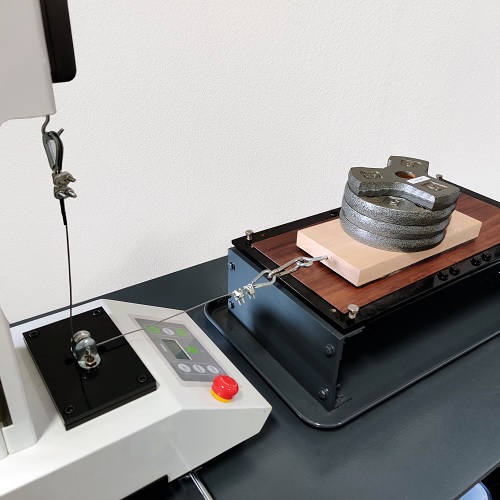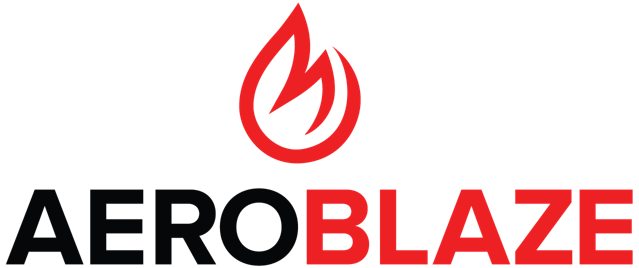Coefficient of Sliding Friction Test for Aircraft Flooring
Coefficient of Sliding Friction Test for Aircraft Flooring
The Coefficient of Sliding Friction Test (also called the Slip Resistance test) is used to determine the dynamic coefficient of friction for aircraft flooring and walkway surfaces. This test is typically performed on all aircraft flooring materials which are likely to become wet in service.
Test Methods

Test Summary
The test samples are placed horizontally on a table with a friction block on top. There are two types of friction blocks: leather and rubber. These blocks are pulled at a constant rate across the test samples in two conditions: dry and wet. This results in four sub-tests run on each test sample. The pass/fail criteria is based on the dynamic coefficient of friction between each block and the test sample, with a minimum 0.45 coefficient of friction in wet and dry conditions.
Test Sample Requirements
Test samples must meet the following requirements:
Regulatory Requirements
This test is typically used to show compliance with the following U.S. Federal Regulations:
Note 1: In the aviation industry, 14 CFR may also be referred to as "FAR" (Federal Aviation Regulations). You may see the requirements listed as FAR 25.793, FAR 25.810, etc.
Note 2: The European Union Aviation Safety Agency (EASA) uses similar Certification Specifications (CS) which correspond to those in the CFR. For example, the EASA regulations are listed as CS 25.793, CS 25.810, etc. These regulations may also be referred to as "JAR" (Joint Aviation Requirements) and listed as JAR 25.793, JAR 25.810, etc.
Products Requiring This Test
All escape routes or floor surfaces on transport category aircraft which are likely to become wet in service must have slip resistant properties in accordance with this test. This includes, but is not limited to:
History of the Coefficient of Sliding Friction Test
In 1960, the U.S. Federal Aviation Administration (FAA) created regulation 14 CFR 25.803(e) "Emergency Evacuation", which stated:
An escape route must be established from each overwing emergency exit, marked and (except for flap surfaces suitable as slides) covered with a slip resistant surface.
(This regulation was moved from 25.803(e) to the newly created 25.810(c) in 1990.)
In 1980, the FAA created regulation 14 CFR 25.793 "Floor Surfaces", which stated:
The floor surface of all areas which are likely to become wet in service must have slip resistant properties..
FAA Advisory Circular AC 25-17, released in 1991 and later amended to AC 25-17A in 2009, provided guidance for meeting these regulations. According to this AC, Military Specifications MIL-W-5044B and MIL-W-5044C, entitled "Walkway Compound, Nonslip and Walkway Matting, Nonslip", provide an acceptable standard for the slip resistance properties required by regulations 25.793, 25.803(e), and 25.810(c).Although the Military Specifications identified in AC 25-17 were canceled in 1998 and no longer maintained, they are still accepted for use by the FAA. The Society of Automotive Engineering (SAE) standard AS8993 was released in 2020 to provide a current source for an equivalent test method. However, the FAA has not released formal acceptance of this procedure so it should not be used for official testing without prior FAA acceptance.
The FAA regulations regarding slip resistance testing are located in the Code of Federal Regulations, Title 14 - Aeronautics and Space, Chapter I - Federal Aviation Administration, Department of Transportation, Subchapter C - Aircraft, Part 25 - Airworthiness Standards: Transport Category Airplanes.
Additional Resources
| Resource | Description |
|---|---|
| 14 CFR 25.793 |
Floor Surfaces (Transport Category Airplanes) U.S. Regulations for FAR 25.793 at Amendment 25-51. |
| 14 CFR 25.810 |
Emergency Egress Assist Means and Escape Routes (Transport Category Airplanes) U.S. Regulations for FAR 25.810 at Amendment 25-114. |
|
FAA Advisory Circular AC 25-17A |
Transport Airplane Cabin Interiors Crashworthiness Handbook Provides acceptable certification methods for demonstrating compliance with the crashworthiness requirements of 14 CFR Part 25. |
| SAE AS8993 |
Coefficient of Friction Test Method for Aircraft Flooring and Walkway Surfaces Society of Automotive Engineering test procedure. |
Ask the Experts

Stuck? Our experts will help you determine the best solution for your needs.
Contact Us